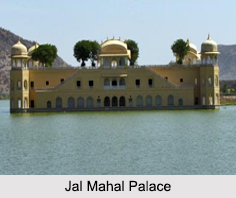 Jal Mahal palace is located on the middle of the Man Sagar Lake in Jaipur city of Rajasthan. The palace and the lake were renovated during 18th century by Maharaja Jai Singh II of Amber. Jal Mahal is a prominent palace exhibiting the Rajput architectural style of grandeur. Jal Mahal was partially damaged due to water logging; recently it was restored by the Government of Rajasthan. The restoration was done by traditional materials for plastering. The plaster consists of a partly organic material- a mortar mix of lime, sand and surkhi mixed with jaggery, guggal and methi powder.
Jal Mahal palace is located on the middle of the Man Sagar Lake in Jaipur city of Rajasthan. The palace and the lake were renovated during 18th century by Maharaja Jai Singh II of Amber. Jal Mahal is a prominent palace exhibiting the Rajput architectural style of grandeur. Jal Mahal was partially damaged due to water logging; recently it was restored by the Government of Rajasthan. The restoration was done by traditional materials for plastering. The plaster consists of a partly organic material- a mortar mix of lime, sand and surkhi mixed with jaggery, guggal and methi powder.
Structure of Jal Mahal
Jal Mahal palace was built in red sandstone with five storied buildings; four floors remain under water when the lake is filled with water. There are chhatris in the four corners of the palace; one rectangular chhatri on the roof was made in Bengal style of art. On the terrace of the palace, a garden was built with arched passages. At each corner of this palace semi-octagonal towers were built with a cupola.
Chhatris and Cenotaphs near Jal Mahal
Opposite the lake at Gaitore, there are chhatris and cenotaphs erected over cremation platforms of some of the Kachwaha rulers of Jaipur. They were built by Jai Singh II. The cenotaphs were erected in the honour of Pratap Singh, Madho Singh II and Jai Singh II. Jai Singh II"s cenotaph is made of marble with intricate carvings and a dome with 20 carved pillars.
Visiting Information to Jal Mahal
Jal Mahal palace is accessible from the Jaipur-Delhi National Highway 8 at a distance of 4 kilometers from Jaipur. The NH also links the city with Mumbai. Regular flights are available to Jaipur International Airport. Trains are also available to Jaipur Railway Station to reach the palace. Jal Mahal palace is not open to visitors.
This article is a stub. You can enrich by adding more information to it. Send your Write Up to content@indianetzone.com



















